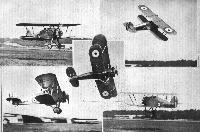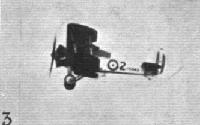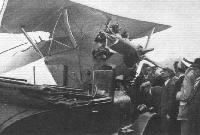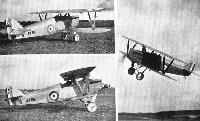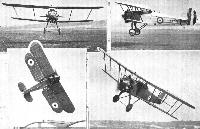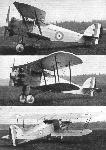
Описание
Страна : Великобритания
Год : 1925
Опытный одноместный палубный истребитель
Hawker Heron, Hornbill, Hawfinch и Hoopoe
Заслуживают упоминания прототипы четырех бипланов, построенных компанией "Hawker" в 1920-х годах. Первым из них был экспериментальный истребитель Hawker Heron, облетанный в 1925 году. Имевший сходство с выпускавшимся серийно Woodcock Mk II, он отличался от последнего новым крылом и оперением и стал первым самолетом компании "Hawker", имевшим цельнометаллический каркас. Оснащенная радиальным двигателем Bristol Jupiter VI мощностью 455 л.с. (339 кВт), машина отличалась хорошей управляемостью, но так и не пошла в серию.
Hawker Hornbill, поднявшийся в воздух в мае 1926 года, был первым новым боевым самолетом, разработанным под руководством Сиднея Кэмма. По конструкции Hornbill был во многом подобен истребителю Heron, за исключением более тонкого фюзеляжа и двигателя Rolls-Royce Condor IV мощностью 698 л. с. (520 кВт). Во время испытаний самолет развивал в горизонтальном полете максимальную скорость 301 км/ч, оказавшись самым быстрым истребителем из тестировавшихся ВВС. К сожалению, его устойчивость на скоростях выше 240 км/ч оставляла желать лучшего, и больше прототипов не строили.
Объединивший в себе черты машин Heron и Hornbill, Hawker Hawfinch был разработан по техническому заданию F.9/26 на одноместный истребитель с радиальным двигателем. От Heron он отличался новым фюзеляжем и двухстоечной бипланной коробкой. Впервые взлетевший в марте 1927 года, самолет испытывался Королевскими ВВС совместно со многими прототипами других фирм, в конечном счете, проиграв контракт на серийное производство Bristol Bulldog. Хотя был построен только один самолет Hawfinch (J8766), он позволил получить фирме опыт разработки истребителей.
Для истребителя-биплана предпочтительной оказалась схема с одностоечным крылом, что продемонстрировал Hawker Hoopoe, в инициативном порядке построенный в 1927 году по техническому заданию Министерства авиации на одноместный палубный истребитель. В первом варианте Hoopoe имел двухстоечное крыло и был внешне очень похож на Hawfinch, но вариант Hoopoe Mk II уже оснащался одностоечным крылом и стойками шасси с обтекателями.
С радиальным двигателем Armstrong Siddeley Panther III самолет продемонстрировал максимальную скорость 315 км/ч. Когда Сидней Кэмм объединил его планер с рядным двигателем Kestrel, появилось семейство классических бипланов фирмы "Hawker", оставившее яркий след в истории авиации.
ТАКТИКО-ТЕХНИЧЕСКИЕ ХАРАКТЕРИСТИКИ
Hawker Hoopoe Mk II
Тип: опытный одноместный палубный истребитель
Силовая установка: один 14-цилиндровый радиальный двигатель Armstrong Siddeley Panther III мощностью 560 л. с. (418 кВт)
Летные характеристики: максимальная скорость на высоте 3810 м - 315 км/ч; потолок 7195 м
Масса: пустого 1263 кг; максимальная взлетная 1774 кг
Размеры: размах крыла 10,11 м; длина 7,47 м; площадь крыла 26,80 м2
Вооружение: два 7,7-мм пулемета Vickers; четыре сигнальные ракеты или 9-кг бомбы под крылом
Описание:
- Hawker Heron, Hornbill, Hawfinch и Hoopoe
- Flight, June 1931
SPECIAL TYPES AT THE DISPLAY
Фотографии
-
Flight 1926-12 / Flight
Регистрационный номер: J6989 [8] The Hawker "Heron" with Jupiter Engine is a metal fighter embodying some novel and advanced constructional features.
-
Air International 1982-03 / Fighter A to Z
Регистрационный номер: J6989 [8] The Heron was a private venture design and the first predominantly metal Hawker fighter.
-
Flight 1927-03 / Flight
Регистрационный номер: J6989 [8] Hawker "Heron" (Bristol "Jupiter"). The "Heron" designed and constructed by the H. G. Hawker Engineering Co., is an experimental high performance single-seater fighter, embodying a number of important features in detail design. It may be described as a development of the "Woodcock" single-seater fighter, constructed by the same firm, already in service production. It is a tractor biplane of the single-bay type, with a large top plane and a. smaller lower one. It has an excellent performance, especially as regards climb, and its manoeuvrability is also good.
-
Flight 1925-09 / Flight
Регистрационный номер: J6989 [8] THE HAWKER "HERON": These views, taken at Brooklands recently, show the machine in various attitudes. Considering the speed at which the machine flies, the quality of these photographs is, we think, quite exceptionally good. The pilot was Flight Lieutenant Bulman.
-
Flight 1925-07 / Flight
Регистрационный номер: J6989 [8] "NEW AND EXPERIMENTAL": Some of the machines which took part in the "Fly Past" at the R.A.F. Display. (3) Hawker "Heron" (400 h.p. Bristol "Jupiter"), a single-seater fighter mainly of metal construction.
-
Flight 1925-06 / Flight
Регистрационный номер: J6989 [8] The Hawker "Heron," a single-seater Fighter of metal construction, fitted with a 400 h.p. Bristol "Jupiter," which will be seen at the R.A.F. Display at Hendon on Saturday.
-
Flight 1925-09 / Flight
Регистрационный номер: J6989 [8] THE HAWKER "HERON": Built for the Air Ministry, the Hawker "Heron" is a single-seater fighter, fitted with Bristol "Jupiter" engine. The machine not yet having been put into quantity production no details may be given, other than those which may be gathered from an inspection of the photographs. The "Heron," designed and built by the Hawker Engineering Company, has a remarkable climb, but actual figures may not yet be published.
-
Flight 1928-07 / Flight
Регистрационный номер: J6989 [8] A King's Cup Non-Starter: The Hawker "Heron" (pilot, Flight-Lieut. P. W. Bulman), which was one of the favourites, had the misfortune to run into a car while taxying to the starting line at Hendon, with the result shown.
-
Aeroplane Monthly 1985-09 / P.Jarrett - The Hornbill enigma (1)
Регистрационный номер: J7782 [20] Another Flight study of the Condor III version in August 1925, showing the blast channel for the Vickers gun.
-
Aeroplane Monthly 1985-09 / P.Jarrett - The Hornbill enigma (1)
Регистрационный номер: J7782 [20] A Flight photograph taken in August 1925 shows the twin underwing radiators, tightly-contoured cowling and the wooden Watts propeller, minus spinner.
-
Aeroplane Monthly 1985-09 / P.Jarrett - The Hornbill enigma (1)
Регистрационный номер: J7782 [20] Taken during the Hornbill's first visit to Martlesham Heath, late 1925/early 1926, the picture shows the outer thirds of each radiator blanked off owing to overcooling problems. The shutters are closed as well.
-
Aeroplane Monthly 1985-09 / P.Jarrett - The Hornbill enigma (1)
Регистрационный номер: J7782 [20] A Hawker photograph of the Hornbill shortly after completion, July/August 1925, with Fairey Reed metal propeller.
-
Flight 1926-06 / Flight
Регистрационный номер: J7782 [20] A HIGH-POWER SINGLE-SEATER FIGHTER: The Hawker "Hornbill," designed and manufactured by the H. G. Hawker Engineering Co., Ltd., is fitted with a Rolls-Royce "Condor" engine. This machine, which will take part in the "Fly-past" at the R.A.F. Display at Hendon on July 3, is of exceptionally clean design, and is very fast.
-
Flight 1926-07 / Flight
Регистрационный номер: J7782 [20] The Hawker "Hornbill" (Rolls-Royce "Condor") Although a single-seater fighter, the "Hornbill," designed by Mr. Camm, chief designer of the H. G. Hawker Engineering Co., is a somewhat different type from the other three, having a much more powerful, but also larger and heavier engine, the Rolls-Royce "Condor," of 670 h.p. The extra size of the engine, and the greater quantity of fuel to be carried, mean a greater power plant and fuel weight, and consequently larger wing area if the same stalling speed is to be retained. In spite of this, Mr. Camm has been very successful in producing a clean machine without sacrifice of speed.
-
Aeroplane Monthly 1985-09 / P.Jarrett - The Hornbill enigma (1)
Регистрационный номер: J7782 [20] Taken by Flight at Brooklands in August 1925, this view of the Hornbill in its first form shows the underwing radiators and the deep rear fuselage. Pictures from this series were not published until June 1926.
-
Aeroplane Monthly 1985-09 / P.Jarrett - The Hornbill enigma (1)
Регистрационный номер: J7782 [20] At Brooklands about the time of the 1926 RAF Display, the newly re-engined Hornbill reveals its underfuselage Serck radiator and the sleeker cowling.
-
Air International 1982-03 / Fighter A to Z
Регистрационный номер: J7782 [20] The Hornbill is illustrated with the original ventral radiator.
-
Aeroplane Monthly 1985-10 / P.Jarrett - The Hornbill enigma (2)
Регистрационный номер: J7782 [20] J7782 back at Martlesham Heath for Service tests, late 1926/early 1927. The Watts propeller is still fitted and the aircraft is unarmed.
-
Flight 1926-07 / Flight
Регистрационный номер: J7782 [20] THE HAWKER "HORNBILL": Among the single-seater fighters which made their first appearance at the R.A.F Display few came in for more favourable comment than the machine here shown. The engine is a Rolls-Royce "Condor."
-
Aeroplane Monthly 1985-10 / P.Jarrett - The Hornbill enigma (2)
Регистрационный номер: J7782 [20] Two Flight studies of the Hornbill at Brooklands in July 1926, after the Condor IV engine had been fitted. It still wears the “new type” number it was given for the RAF Pageant at Hendon, and has the Watts walnut propeller.
-
Aeroplane Monthly 1985-10 / P.Jarrett - The Hornbill enigma (2)
Регистрационный номер: J7782 [20] This July 1926 view emphasises the much greater chord of the top wing.
-
Aeroplane Monthly 1985-09 / P.Jarrett - The Hornbill enigma (1)
Регистрационный номер: J7782 [20] Flt Lt P. W. S. Bulman demonstrates the modified Condor IV-engined Hornbill for Flight at Brooklands in July 1926. Note the Hendon “new type" number on the fuselage.
-
Flight 1926-07 / Flight
Регистрационный номер: J7782 [20] THE HAWKER "HORNBILL" in various attitudes, as piloted by Mr. Bulman
-
Aeroplane Monthly 1985-10 / P.Jarrett - The Hornbill enigma (2)
Регистрационный номер: J7782 [20] Hawker Hornbill J7782, with Hawker test pilot Flt Lt P. W. S. Bulman at the controls, performs for the benefit of Flight’s photographer at Brooklands in July 1926.
-
Aeroplane Monthly 1985-09 / P.Jarrett - The Hornbill enigma (1)
Регистрационный номер: J7782 [20] Bulman demonstrating the modified Hornbill for Flight in July 1926. Pictures taken during the session were first published only a month after the first appearance of pictures taken 11 months earlier. Note the increased fin area.
-
Aeroplane Monthly 1985-10 / P.Jarrett - The Hornbill enigma (2)
Регистрационный номер: J7782 [20] A slightly later picture, again during the Martlesham Service tests, shows J7782 with a Fairey Reed propeller. The Vickers gun is installed and the “new type" number is crudely overpainted
-
Aeroplane Monthly 1985-10 / P.Jarrett - The Hornbill enigma (2)
Регистрационный номер: J7782 [20] The Hornbill at RAE Farnborough about October 1928. Automatic slats had been fitted to the leading edges of the upper wingtips, altering the tip curvature. The deep-chord rudder, fitted during Service tests, is evident.
-
Aeroplane Monthly 1985-10 / P.Jarrett - The Hornbill enigma (2)
Регистрационный номер: J7782 [20] Late in life J7782 had its rear fuselage recovered, as evidenced by the new-style serial number. The bulge beneath the fuselage is for instrumentation. Taken at Farnborough about 1932, with the Watts propeller back again.
-
Flight 1928-06 / Flight
Регистрационный номер: J8776 [7] HAWKER "HAWFINCH": Single-seater Fighter, with Bristol "Jupiter" Engine.
-
Flight 1929-01 / Flight Advertisements
Регистрационный номер: J8776 [7] A single-seater fighter of outstanding merit incorporating the Hawker patent system of metal construction.
-
Aeroplane Monthly 1996-05 / M.Rowe - Cameras in the sky
Регистрационный номер: J8776 [7] A classic Flight photograph of the Hawker Hawfinch prototype "anti-photographer" aircraft taken at Brooklands in 1927. The pilot was “George” Bulman.
Classic John Yoxall photograph of the Hawker Hawfinch low and fast at Brooklands in March 1927. No motor-drive was used to take this photograph - only an unwieldy plate camera and a lot of faith in the pilot, in this case “George" Bulman. Only one Hawfinch was built, the RAF choosing the rival Bristol Bulldog as its new fighter. -
Flight 1928-08 / Flight
Регистрационный номер: J8776 [7] THE HAWKER "HAWFINCH" IN FLIGHT: These four views from various angles give some idea of the manoeuvrability of the machine. The front view is a very remarkable picture, and shows good "team work" between our photographer and Mr. Bulman, Hawker's Chief Test Pilot.
-
Aeroplane Monthly 1974-06 / Hawker Hawfinch /Press Debut/
Регистрационный номер: J8776 [7] -
Aeroplane Monthly 1974-06 / Hawker Hawfinch /Press Debut/
Регистрационный номер: J8776 [7] -
Flight 1928-08 / Flight
Регистрационный номер: J8776 [7] A MODERN SINGLE-SEATER FIGHTER: The Hawker "Hawfinch," Bristol Series VII "Jupiter" engine, incorporates several unusual features. In spite of its diminutive size, its biplane wings show two-bay bracing. The small lower plane, pronounced stagger, and low placing of the top plane result in an excellent view, coupled with a very rigid wing structure. These three views give a good idea of the general lay-out.
-
Flight 1929-07 / Flight
Регистрационный номер: N237 [3] THE HAWKER HOOPOE is an experimental deck-landing Fleet Fighter, fitted with Bristol Mercury Engine.
-
Flight 1931-06 / Flight
Регистрационный номер: N237 [3] -
Мировая Авиация 152
Регистрационный номер: N237 [3] Hawker Hoopoe создавался по техническому заданию N.21/26 Министерства авиации. Самолет Hoopoe II (на снимке) стал предшественником превосходного истребителя Fury.
-
Aeroplane Monthly 1985-09 / P.Jarrett - The Hornbill enigma (1)
A Hawker inboard profile of the forward fuselage, dated May 1925, shows the Condor III installation, with underwing radiators. Although the Vickers machine gun is shown, the CC interrupter gear was not compatible with the engine.
-
Air International 1982-03 / Fighter A to Z
The Heron was a private venture design and the first predominantly metal Hawker fighter.
-
Air International 1982-03 / Fighter A to Z
The general arrangement drawing illustrates the Hornbill in the form in which it was first flown. The Hornbill was one of the fastest fighters of its day.
-
Aeroplane Monthly 1985-10 / P.Jarrett - The Hornbill enigma (2)
Hawker Hornbill
-
Мировая Авиация 152
Hawker Hawfinch
- Фотографии



